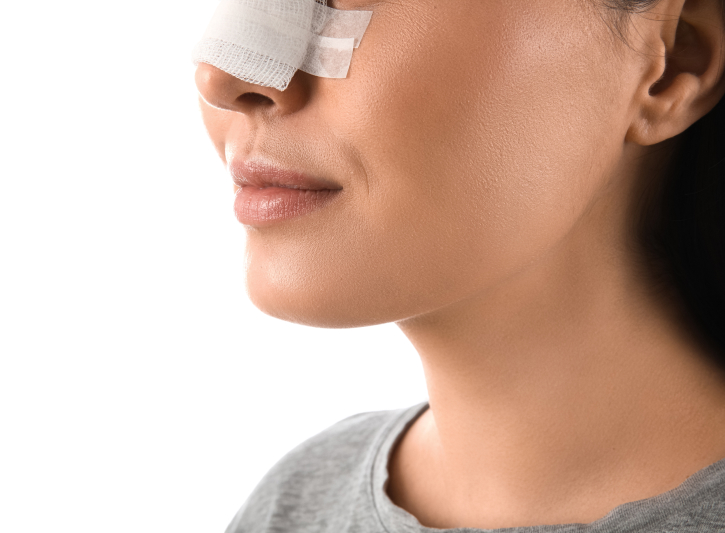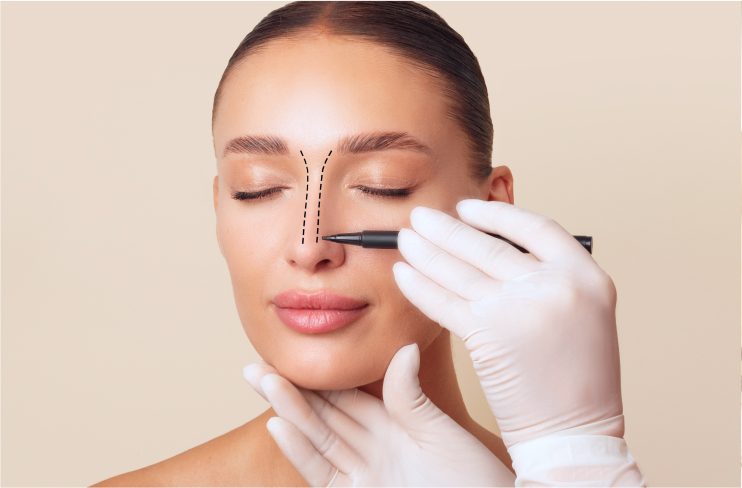Rhinoplasty in Singapore

What Is A Rhinoplasty?
Rhinoplasty, more commonly known as a nose job, is an operation to enhance the appearance of the nose and/or improve its function. It is usually performed for purely cosmetic reasons, which include changing the shape and proportions of the nose. However, it is also done for medical purposes, such as to treat breathing problems and repair deformities caused by injuries or birth defects.
Nose surgery involves reconstructing the nose’s bone, cartilage or skin, depending on the patient’s facial anatomy, health and desired results, and the surgeon’s assessment. No two cases are alike, and each patient will have a customised treatment plan specially crafted for him or her.
Who Should Consider Rhinoplasty?
People consider rhinoplasty for various medical or cosmetic reasons. These include:
- Those who wish to change the appearance of their nose (due to having features such as a flat nose bridge, or a wide and bulbous nasal tip, or an upturned nose, etc.)
- Those with congenital nasal defects, such as a deviated septum
- Those who experience difficulty breathing due to a previous nose injury (e.g. broken nose)
What Are the Benefits of Rhinoplasty?
Enhanced Appearance- Rhinoplasty refines the size, shape, and angle of your nose, creating a more balanced and aesthetically pleasing profile.
Improved Breathing Function- This procedure can address breathing difficulties caused by blocked or narrow nasal passages, allowing you to breathe more easily.
Nose Restoration- Rhinoplasty can reconstruct and repair noses with structural deformities due to injury, illness, or birth defects.
We provide a wide range of procedures to enhance the form and function of the nose with natural-looking outcomes.
For a personalised consultation, please reach out to us today.
How Is a Rhinoplasty Done?
A rhinoplasty is typically performed in an outpatient setting under local or general anaesthesia, depending on the plastic surgeon’s preference and the complexity of the operation itself. Generally, the process involves creating a small incision at the base between the nostrils or inside the nose to access and readjust the bone and cartilage underneath. Implants, or bones and cartilage harvested from other parts of the body, may be used to restructure the nose.
There are two main approaches to nose surgery:
Closed Rhinoplasty
The operation duration and its subsequent recovery period are much quicker compared to the open approach. The procedure, however, is more complicated.
Open Rhinoplasty
Though more invasive, open rhinoplasty is considered more effective in treating more serious cases, such as disfigurements, because of the better visibility it provides to the surgeon. The recovery period will be longer than in closed rhinoplasties and may cause temporary swelling and bruising. It may also leave a visible scar, which should fade over time.
Other procedures used to enhance the shape of the nose include filler rhinoplasty, where fillers are injected to make minimal improvements or correct minor issues with the nose. However, the effects of this treatment are not permanent.
Dr Leo Kah Woon is an experienced rhinoplasty surgeon in Singapore who tailors each procedure to the individual’s desired aesthetic and functional goals.
Rhinoplasty by Dr Leo
Dr Leo prefers to use the composite rhinoplasty technique when dealing with Asian noses. This involves the use of silicone implants for the nose bridge enhancement. Further tip plasty is carried out to debulk the excess fat and cartilage at the nasal tip and the patient’s own ear cartilage is harvested and placed at the nose tip to give further projection and definition. To correct an upturned or “piggy-nose” deformity, alloplastic material can be placed at the caudal septum, lengthening the nose. Alarplasty can also be performed if needed.
This is a day surgery procedure performed under sedation by the anaesthetist. The procedure time is around 2 hours. Stitches at the columella are removed after one week and stitches at the alar are removed after 10-14 days.
What Are the Risks of Rhinoplasty?

Like any surgical procedure, rhinoplasty carries some potential risks, including:
- Bleeding
- Infection
- Allergic reaction to anaesthesia
- Numbness
- Skin discolouration
- Nosebleeds
- Difficulty breathing
- Improper healing or noticeable scarring
However, the likelihood of these happening is unlikely in the hands of an experienced surgeon; and can very often be well-managed.
FAQs About Rhinoplasty
